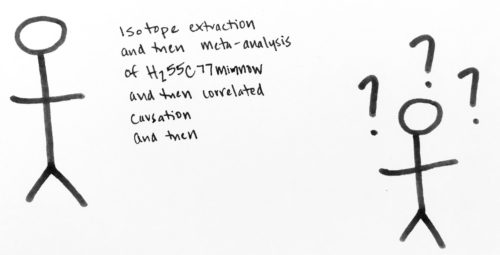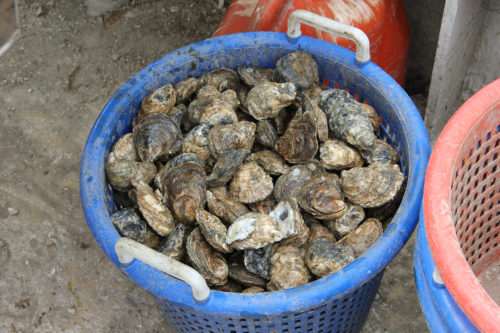Want to be a better science communicator? Start with the title and the abstract.
Amanda Rockler ·By Amanda Rockler
Dr. Bill Dennison says, “storytelling and visualizations are part of our DNA,” and good storytelling engages the audience, improves retention, and shortens reading time, but telling a good story is difficult, therefore our science visualization class is learning how to craft the perfect message!
In a 2017 NPR interview with science communicator Alan Alda, Alda says,
"People are dying because we can't communicate in ways that allow us to understand one another…It sounds like an exaggeration, but I don't think it is. When patients can't relate to their doctors and don't follow their orders, when engineers can't convince a town that the dam could break, when a parent can't win the trust of a child to warn her off a lethal drug. They can all be headed for a serious ending." Our job as scientists is to find the truth, but it is also to tell good stories. In this week’s class, we worked on communicating our research by crafting a title and abstract statement, we then used ‘group think’ in class to revise the titles and statements.
Quick tips for title writing success:

Original
title…
There is no silver bullet: Increasing implementation of residential-scale stormwater practices requires diverse solutions.
Advice…
Take out
the big words, reword, and reorganize
Revised
title…
Diverse solutions are required to increase residential stormwater practice rates. It certainly reads much cleaner, but I did like the catchy silver bullet in the original.
After we reviewed the titles, we moved on to analyzing the ABT, ‘and, but, therefore’ statements. Ever been in a situation where a person is telling you about their research and they just ramble on and on?

ABT was
developed by marine scientist turned filmmaker, Randy Olsen who discovered that
three little words can give a story structure and solve the ‘and then’ problem.
If you want to see Randy in action, check out his Ted talk.
A good ABT
sets up the topic and discusses its relevance (the Why), then it creates
tension with But and then resolve with Therefore.
Here is a template for developing an ABT:
[This is true and observable] and [this is true and observable OR this data exists], but [problem statement], therefore [this is how we are addressing the problem].
Seems simple enough right? I certainly struggled on the first attempt…
Outreach programs that focus solely on building knowledge and awareness do not lead to long-term behavior change, but when used in conjunction with diverse financial and behavior science tools, they can. Therefore, to increase the adoption rates of residential-stormwater best management practices, we must create outreach programs that integrate knowledge and awareness with diverse financial and behavioral science strategies.
After good feedback from my peers and instructors, most specifically that my and was a conjunction, my new statement looks like this…
Increasing residential stormwater best management practices is critical to meeting the Chesapeake Bay water quality goals and a majority of current education and outreach programs are designed to improve knowledge and awareness of the best management practices, but social science tells us that increasing knowledge and awareness alone will not change behavior. Therefore, we must create outreach programs that integrate knowledge and awareness with diverse financial and behavioral science strategies in order to change behavior and increase number best management practices installed.
I still think that I have a lot to learn in crafting effective titles and ABT statements, but it is pretty fun once you get started and I found that throughout the week I was making up ABT statements everywhere I went. Practice makes perfect?
Here is
one from this morning…
Thomas is a tank engine (true) and lives and works on the Island of Sodor (true), but Sir Topham Hat does not pay Thomas for his work (problem), therefore Thomas should strike (resolution!) (Maybe I shouldn’t be letting my three-year old get super invested in an archaic dystopia).

And one
from this afternoon…
The eastern oyster is an important species to the Chesapeake Bay economically and ecologically and provides numerous ecosystem services, but oysters themselves are not in the mood for love until summer therefore the hatcheries convince them it is summertime to get them to spawn.

It’s fun right?
Is there something you would like to communicate? Research you would like to share? Wanna take your shot at captioning a New Yorker cartoon or telling a captivating story? ABT can help!
Try it yourself in the comments section below!
Next Post > Ken Barton Sails Into Retirement
Comments
-
Srishti Vishwakarma 6 years ago
Great blog, Amanda! I really liked how you connected the ABT format with some examples from news. Your blog clearly synthesizes the discussion during the class.
-
Madeline Farmer 6 years ago
We will write many ABT statements in the future and will need to communicate effectively, but an ABT statement can be challenging to write, therefore your template and examples will be a fantastic resource!
-
Morgan Ross 6 years ago
Amanda, great blog to start off the semester. I love how you used the ABT format throughout the post, it really keeps the audience engaged (go figure). You also did a good job of bringing in outside material to support the information we discussed in class. I'm so impressed by your handmade visuals!